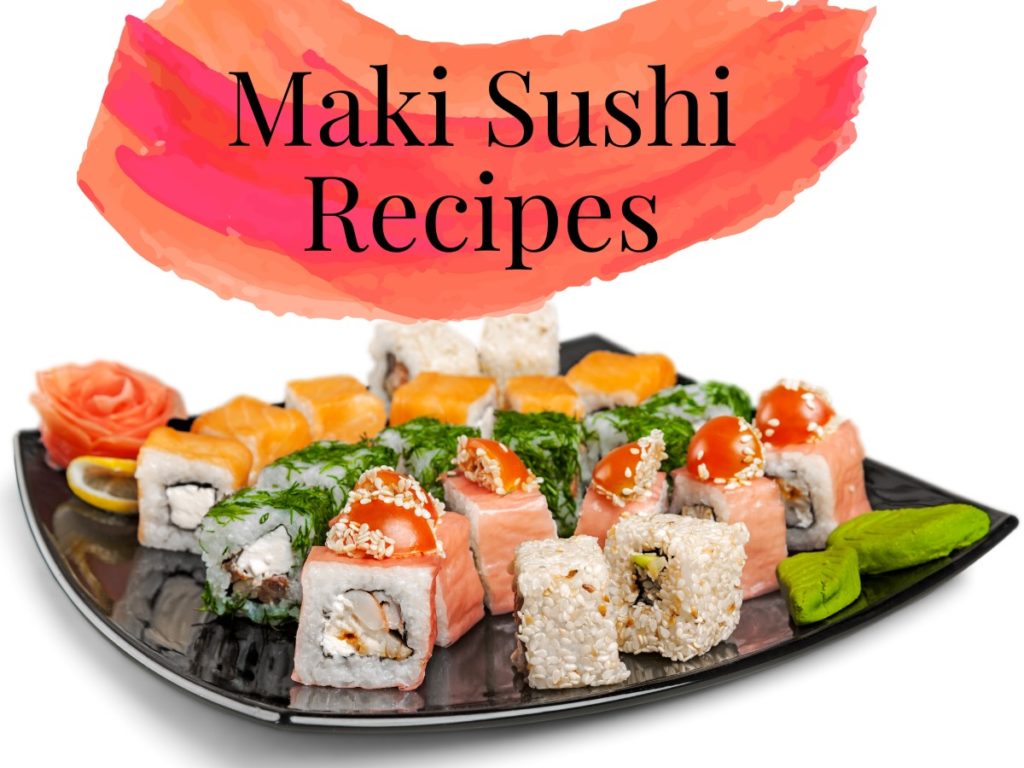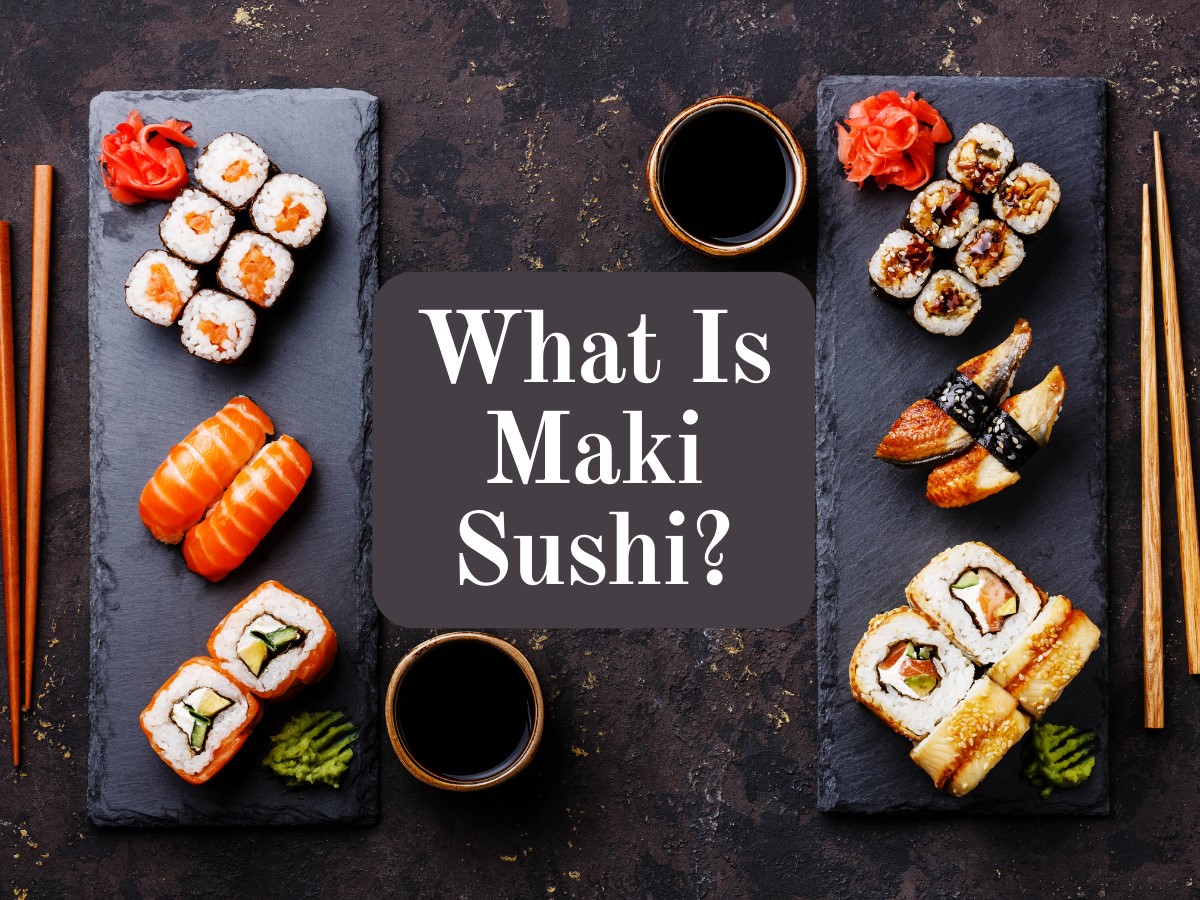When we think of Japanese food, the first meal that comes to our mind is sushi. The balls of vinegared rice wrapped in seaweed nori sheets with a center of fish, seafood, or vegetables are probably everyone’s favorite feast. So what is maki sushi? Maki or Makizushi is the old name for sushi. More precisely, maki refers to rolled sushi rice, where ‘sushi’ means rice seasoned with vinegar.
Moreover, maki sushi can be balled into a cylinder with a thin strip of cucumber, soy paper, cabbage, and omelet despite the traditional nori sheets. Read on to delve into Japanese sushi recipes.
What is Maki?
Maki, also known as Makizushi, are the traditional sushi rolls of sour rice with a core of seafood or veggies wrapped in nori sheets. There are several types of maki sushi based on the folding technique and size. Moreover, you can find many maki sushi recipes in Japan; this article includes a few.
Types of Maki
Maki sushi rolls are of different sizes, shapes, and patterns, which depend on the folding technique, portion of rice and proteins, and cutting forms.
Inside Maki Rolls
Inside maki sushi rolls comprise a cube of rice wrapped in a nori seaweed, cucumber strip, or an omelet. Moreover, inside rolls have the following categories depending on the thickness and filling ingredients.
Futomaki
Futomaki is the thickest and largest maki sushi roll, also known as “fat-rolled sushi.” The specialty of this sushi roll is the 2-2.5 inches diameter filling ingredients, including fresh and dried vegetables, fish, and seafood like uni, unagi, and anago. Moreover, a thin roasted nori sheet and sour rice wrap the delectable inside.
Chumaki
Chumaki is a mediumly thick maki sushi roll of about 1-1.5 inches in diameter comprising two to three filling ingredients inside the rice and nori wrap.
Hosomaki
In Japanese, Hosomaki means thin rolls. A makizushi recipe made from vinegared rice and only one filling ingredient to maintain the shape. Thin nori sheets and bamboo mats aid in rolling hosomaki. Moreover, the inside ingredients can be tuna fish, eel, pickled daikon, or cucumber.
Inside-Out Maki Rolls
Inside-out, a makizushi recipe comprises filling ingredients wrapped in a nori sheet further draped with sour rice.
Uramaki
Uramaki is an inside-out maki sushi roll in which the roasted dry nori sheets wrap the filling ingredients, which are again covered with a layer of vinegared rice. In uramaki, people usually add salmon roe (eggs) to bind the ice firmly on the seaweed.
Handrolls
Hand rolls are just like tortilla wraps that swaddle all the ingredients, including sour rice in a nori seaweed sheet. It needs no bamboo mats for folding or chopsticks for eating. You can pick the roll in your hand and dig into its savoriness.
Temaki
Temaki is a type of hand roll resembling the shape of an ice cream cone comprising all the ingredients swaddling inside a large nori sheet.
Maki vs. Sushi
Sushi is a Japanese meal comprising vinegared rice, seafood, fish, vegetables, and seaweed, either cooked or raw. In contrast, maki is a cylindrical-shaped roll made with sushi rice wrapping some pieces of fresh or raw seafood, fish, vegetables, fruits, and salmon roe. In short, sushi can be of any shape, whereas maki sushi only stands for a cylindrical roll.
Maki vs. Sashimi
Sashimi is a classic Japanese delicacy comprising raw fish slices trimmed with a unique Japanese cutting technique that requires several years of practice. Japanese sauces and dips, such as wasabi and soy sauce, are excellent for savoring raw fish. Moreover, this meal does not include rice, seaweed, and vegetables as required to make a maki sushi roll.
Maki vs. Nigiri
Nigiri is a kind of sushi that comprises a ball or cube of hand-pressed sour rice draped with thin slices of raw meat such as fish, uni (sea urchin), eel, scallops, or shrimp. Despite the meat slices, nigiri sushi also includes thin slices of raw vegetables and fruits such as mango or avocado. A small dab of wasabi is applied to affix the upper toppings with rice.

Japanese Popular Maki Sushi Recipes
Here are some popular maki sushi recipes with their signature ingredients.
- Boston Roll (poached shrimp with creamy avocado slices)
- Dragon Roll (spicy tempura)
- California Roll (crab or raw fish)
- Volcano Roll (spicy tuna and shrimp)
- Rainbow Roll (salmon or tuna avocado-wrapped rolls with no nori)
- Tiger Roll (shrimp, crab, unagi, and sweetened soy)
- Alaska Roll (salmon inside-out roll deep-fried with panko crumbs)
- Spider Roll (deep-fried crab and sweetened soy)
- Tuna Roll (canned tuna and mayonnaise)
- Salmon Roll (spicy or smoked salmon and sriracha sauce)
- Avocado Roll (fresh avocado slices)
- Philadelphia Roll (smoked salmon and Philadelphia cream cheese)
FAQs
Why Is Sushi Called Maki?
Maki is the name for sushi rice that has been rolled into a cylinder form with several fillings wrapped in nori seaweed. In contrast, sushi can be of any shape, comprising vinegared rice, seafood, fish, and seaweed.
Is Maki Sushi Raw Or Cooked?
You can prepare maki sushi either with cooked or raw ingredients. Typically, the Japanese make maki sushi with raw fish and seafood.
Is Maki Sushi Healthy?
Maki sushi is a healthy meal since seafood and fish provide a rich source of protein and omega-3 fatty acids. Vegetables and fruits that are usually optional offer many vitamins and minerals. Moreover, sushi rice is an excellent source of carbohydrates.
How Often Can I Eat Maki Sushi?
An adult human can safely have two to three sushi rolls in a day or about 15 rolls in a week. It is a high-risk meal, so ensure it is free from contamination.
Is Maki Sushi A Junk Food Or a Cheat Meal?
Maki sushi is an entirely healthy meal. Since the ingredients are alterable, you can change the nutritional value of a sushi roll. For example, adding deep-fried tempura to a nori wrap will have more calories than maki sushi comprising raw fish.
Is Maki Sushi High Risk?
Maki sushi is a high-risk meal it is because of the raw fish and seafood in it. Raw meat easily gets contaminated with harmful bacteria that may cause food poisoning in human beings. Therefore, if you are making or buying maki sushi, ensure it is free from contamination and packaged appropriately.
Can You Lose Weight With Maki Sushi?
Since maki sushi contains a high proportion of proteins and omega-3 fatty acids, and a limited portion of carbs, you can quickly lose weight. Omega-3 fatty acids help regulate cholesterol and sugar levels and reduce LDL (bad cholesterol). Moreover, proteins are helpful for muscle building. You can add fresh fruits and vegetables to your maki sushi for an extra punch of vitamins and minerals.
Related Article: How To Cook Sushi Rice Like A Michelin Star Chef

